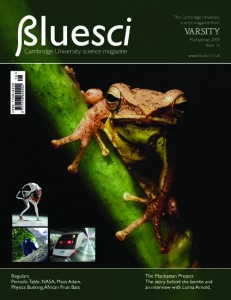MONDAY, 4 JANUARY 2010
This issue’s cover image shows the endangered saddled tree frog Polypedates eques, which lives in the cloud forests of Sri Lanka. It was photographed by Rohan Pethiyagoda Jr, a third-year natural sciences student, while on a recent field trip to conduct a frog census.The world’s frogs are disappearing. According to the latest assessment by the International Union for Conservation of Nature, nearly one third of amphibian species world-wide are threatened with extinction and 35 species are now extinct. Of those species confirmed to be extinct, 21 were endemic to Sri Lanka.
Habitat degradation is thought to be the main driver for the demise of amphibians in Sri Lanka, where 51 species are threatened with extinction. Less than two per cent of the island’s original rainforests remain. During British colonial rule, large swathes of forest were cleared for rubber, coffee and tea plantations. This, along with subsequent demand for agricultural land by the island’s growing population, has put a huge strain on Sri Lanka’s biodiversity, in particular its unique amphibians.
Rohan worked on a 50 acre site that used to be a tea plantation. In 1999, as part of a restoration initiative, the tea was removed and the forest was allowed to regenerate. Now, less than a decade later, the site is covered with dense vegetation. However, rather than indigenous tropical forest plants, it is populated mainly by two foreign species; an Australian tree (Acacia) and a tropical American shrub (Austroeupatorium). These were introduced to the island in the 1900s as exotic garden plants. These two species now occupy more than 70 per cent of the study site. While this has important implications for restoring Sri Lanka’s mountainous rainforests, it is not only the plants that make this study site so special.
Ten endemic, endangered frogs have made the former tea plantation their home. Frogs are known to be very selective of habitat, and hardly any are found in the tea plantations surrounding the study site. Of the fifteen frog species known to inhabit the native forest nearby, thirteen of them (ten of which are endangered) have now settled in the site’s exotic vegetation.
Conservation of amphibians is important for the world’s ecosystems. They provide food for prey, such as birds and lizards, and are in turn predators of insects, including pest species. They serve as valuable ‘indicator species’ for environmental quality, and tadpoles control algae in streams and ponds. From a human perspective, the skin secretions of some amphibians have antimicrobial, antifungal and analgesic properties from which novel pharmaceuticals have been developed.
Rohan’s study suggests that some amphibians categorised as endangered may be tolerant of disturbed or altogether novel habitats. This substantially lowers their risk of extinction and allows conservation action to be focused on habitat-specialised species that may be more sensitive to environmental degradation and therefore need more urgent attention.
Katherine Thomas is a PhD student in the Department of Physics



